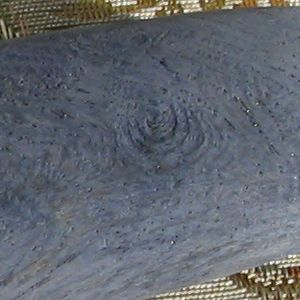12AX7
Post Harlot
    
Posts: 4803
Registered: 8-3-2005
Location: oscillating
Member Is Offline
Mood: informative
|
|
Iron ions and oak?
Okay, I carved a piece of oak burl (that's been out in the wood pile for five years, probably a little rotted but feels solid) into a knife
handle and having finished it, I installed the carbon steel knife (also hand made) and sat back to enjoy it. Little did I know, by the next day it
had corroded the shank and stained the inside dark blue, almost black! So to see what was going on, I dipped it in a weak ferrous sulfate solution,
thinking iron ions would catalyze whatever the hell was going on. And catalyze it did!

(Closeup of right end attached.)
You can see some wood tones in there but for the most part it's a solid blue-purple-black color, like prussian blue! But how? Wood by itself
doesn't have any cyanides in it. Could it have to do with its past environment?
Acid neutralizes the color, at least temporarily. At the moment I have it sitting in a mild acidic bleach solution (HCl + CaOCl) to see if I can just
nuke out whatever it is that's doing this...
Tim

|
|
|
chloric1
International Hazard
    
Posts: 1070
Registered: 8-10-2003
Location: GroupVII of the periodic table
Member Is Offline
Mood: Stoichiometrically Balanced
|
|
tannins?
I was just reading about chemistry in ancient Mesopotamia. There they mentioned the classic ferrous sulfate and nutgulls for ink. Would this wood
have natural tannins? Just a thought.
Fellow molecular manipulator
|
|
|
12AX7
Post Harlot
    
Posts: 4803
Registered: 8-3-2005
Location: oscillating
Member Is Offline
Mood: informative
|
|
Oh, absolutely, and I can see something this black being used for ink. But how do tannins react with iron to produce a dark colored complex?
(BTW, the chemical is soluble at least somewhat: I had a light yellow to orange "oak burl tea" solution that instantly turned black on the
addition of a pinch of iron sulfate. It makes a dark bluish solution on dilution; it isn't a "thick" color like concentrated iron
cyanide.)
Tim
|
|
|
Mr. Wizard
International Hazard
    
Posts: 1042
Registered: 30-3-2003
Member Is Offline
Mood: No Mood
|
|
It looks like the tannic acid in the oak reacts with the iron and you get ferrous or ferric tannate. It will do the same thing with coffee. It was
in the first chemistry set I ever got. Many other soluble metal salts form insoluble tannates as well. Try some commercial rust or stain removers on
it, or on a scrap of similar wood. You might try sulfamic acid, oxalic acid, or even phosphoric to dissolve out the iron. As you speculated, maybe
there are other soluble salts in the wood. What was the source of the wood?
|
|
|
12AX7
Post Harlot
    
Posts: 4803
Registered: 8-3-2005
Location: oscillating
Member Is Offline
Mood: informative
|
|
Like I said, a possibly somewhat rotten piece of crotch (the intersection of limbs makes a nice irregular grain) from our wood pile, of what should be
white oak. The tree was cut down 8 years ago because it was somewhat diseased and more importantly, it was overhanging our roof, causing rot.
Humm... anything I could complex it with that's insoluble? Preferably not poisonous, so, lead and barium are out...
Tim
|
|
|
unionised
International Hazard
    
Posts: 5104
Registered: 1-11-2003
Location: UK
Member Is Offline
Mood: No Mood
|
|
IIRC the tannins (condensed poly phenols/ cathchols) are produced by the tree to deter attack by fungi. If the tree was already rotten in parts then
you mght have unexpectedly high tannin levels.
I'm not sure, but it might be worth trying aluminium as a competitor for the tanins or oxalic acid to reduce the Fe+++ to Fe++, then varnishing
it to top air re-oxidising it.
|
|
|
chloric1
International Hazard
    
Posts: 1070
Registered: 8-10-2003
Location: GroupVII of the periodic table
Member Is Offline
Mood: Stoichiometrically Balanced
|
|
Oxalic
Definately Oxalic acid is the way to go.  I had a morter and pestel stained with
iron oxide since 2002 and the strong acids HCL and H2SO4 only took out 30 or 40%. I had a morter and pestel stained with
iron oxide since 2002 and the strong acids HCL and H2SO4 only took out 30 or 40%.  
BUt then about a month ago I heated water to about 70 degrees Celcius to increase the solubility of oxalic acid and got a surprising amout of the acid
to dissolve. I poured the solution into the morter and every trace of iron was gone in 20 minutes! This stuff is amazing! I have my white morter and
pestle back  
[Edited on 10/6/2005 by chloric1]
Fellow molecular manipulator
|
|
|